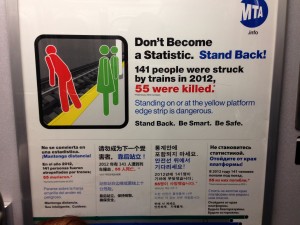Where does Culture Go in Globalization?
Posted on November 16, 2013 | posted by:The world is becoming more and more globalized by multinational corporations, high technologies, credit cards, tourism, fast food and so on. For example, McDonalds is so widely distributed that it now acts as a symbol of globalization. The Economist magazine has even created a “McDonalds index,” which compares the cost of living around the world by looking at the local price of a BigMac, which has become a kind of universal currency. As Marshall Mcluhan points out, we are living in a “global village”. The epitome of globalization can be seen more clearly in an international city like New York City. In the subway, you can listen to music from every part of the world; on the street, you can hear random conversations of all different language; in the museum, you can come across various arts in the world; and what’s more, on the Internet, you can get news of any place of the world. However, the media that makes globalization possible also creates communities with “no sense of place”(Meyrowitz 1985). In globalization, what are we losing?
In the last 15 years, cities in China have become more similar to each other, especially those that are highly developed. It is often the case that when I travel by plane and go out of the airport, I cannot tell where I am from its architectures and streets. Not only cities, but also products in the market tend to look like each other. As modern Chinese cities are becoming more westernized, it is difficult to find objects of typical Chinese culture in the market. Since Chinese society is so dramatically influenced by western culture, as a Chinese design student, I wonder whether the design we do is representative of Chinese or western culture.
As designers are affected by globalization, are we losing our culture of origin? How should we look and act in response to the changes of our local culture? Is it the designer’s role to preserve local culture? What does globalization mean to designers? One day, as I was thinking about all these big issues around globalization, I saw a poster in the subway:

In the poster of MTA, below the English version of warming people to stay away from the platform edge are four other versions of other languages with the same content.
It occurred to me that whether design is powerful enough to make a big difference or not, designers should be aware of the bigger context in which we design. In the case of the poster, its designer understands the global makeup of NYC and realizes that it should be designed at a global scale.
In New York City, one of the most cosmopolitan cities in the world, instead of hearing people speak English all the time, we often find more people speak foreign languages; instead of seeing uniformity of western culture, we often find the city full of diverse cultures. People are influenced by other cultures through mass media, but still value and stick to their own culture, because people feel secure in their local identities.
Due to globalization, some aspects of culture have changed dramatically, while other parts have not. Japanese culture, for example, has been able to take in a host of other cultural elements (such as food, religion, entertainment and so on) from abroad without losing its own unique identity. For instance, baseball did not turn Japanese culture into American culture, but conversely baseball became Japanese. Similarly, Americans have loved and adopted sushi without becoming culturally more Japanese.
Sheikha Al Mayassa, a patron of artists, storytellers and filmmakers in Qatar, said in a TED talk:
- “the more the world is flat, if I use Tom Friedman’s analogy, or global, the more and more people are wanting to be different. Young people are looking to become individuals and find their unique differences amongst themselves. This is why I prefer the Richard Wilk analogy of globalizing the local and localizing the global. We don’t want to be all the same, but we want to respect each other and understand each other. Therefore tradition becomes more important, not less important.”
I cannot agree more with Mayassa that instead of replacing localization, globalization actually makes local culture and tradition even more important than ever. We all need our local culture to maintain a sense of belonging, which is also the antidote to the lost feeling of “no sense of place”.
On one hand, we need to keep up with the pace of globalization, trying to be part of it; on the other hand, we need to reconnect and reassert our own culture. The hard part is to keep a balance of them and I believe design plays an indispensable role in it.
Below is the TED talk of Sheikha Al Mayassa I mentioned. Enjoy it! ; )
Sheikha Al Mayassa: Globalizing the local, localizing the global